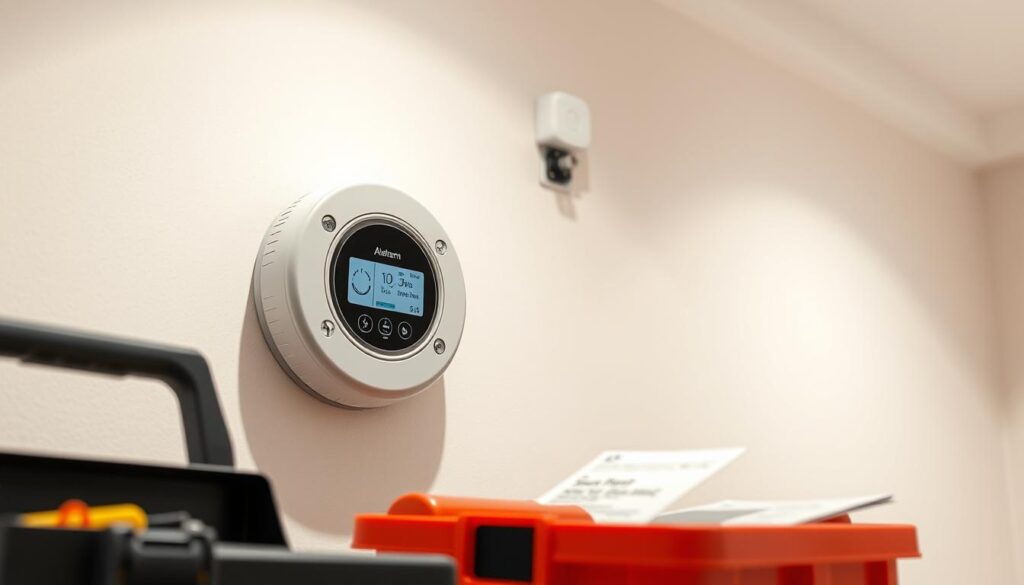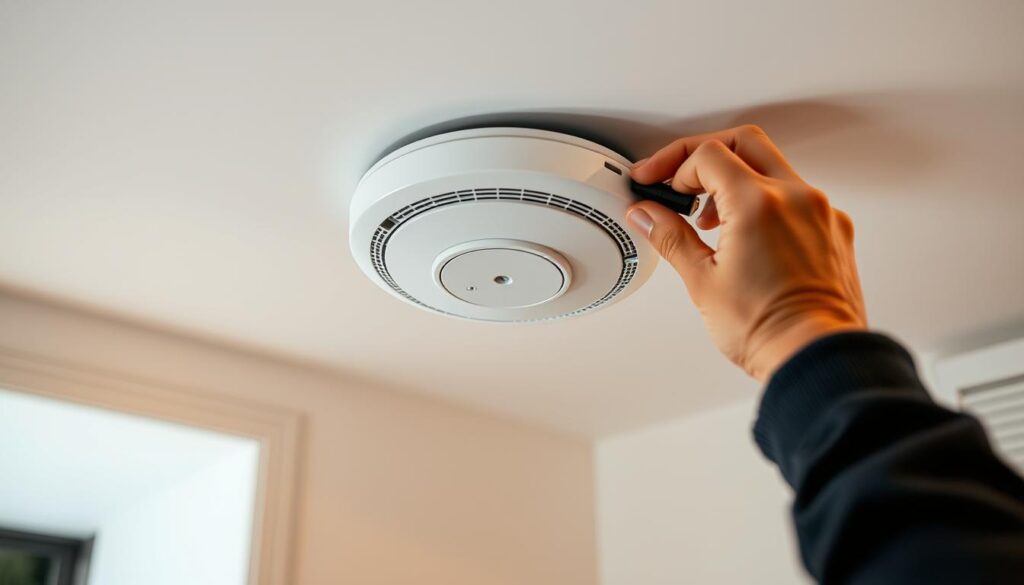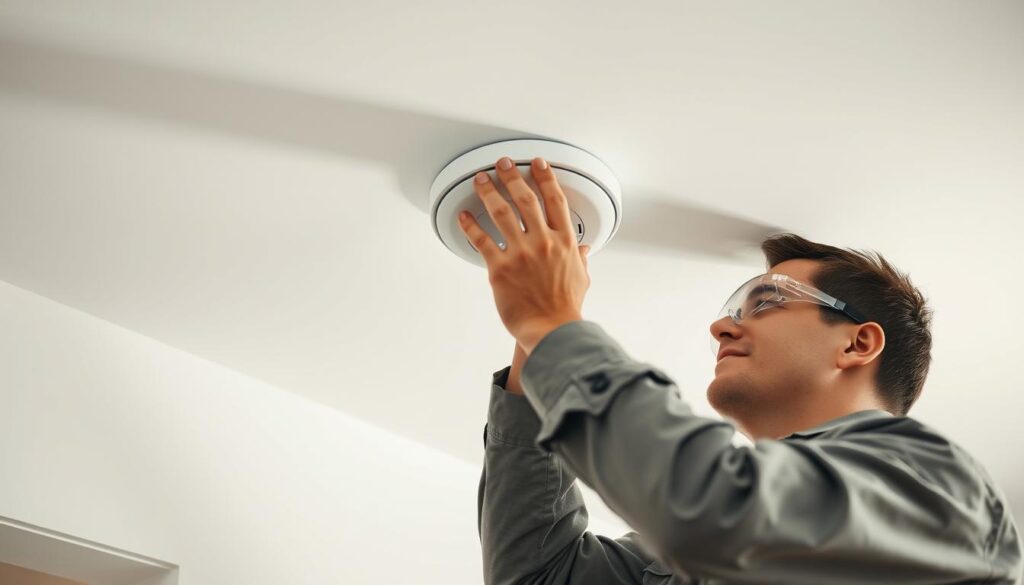Are you aware that a properly installed smoke alarm system can significantly reduce the risk of fire-related injuries and fatalities in your home? As a homeowner, it’s essential to understand the importance of having a reliable smoke detection system in place.
Modern smart smoke alarms offer advanced features and connectivity options that can revolutionise home safety. Unlike traditional smoke detectors, smart smoke alarms can be integrated into your existing smart home setup, providing real-time alerts and potentially saving lives during emergencies.
To ensure your home is equipped with an effective smoke detection system, it’s crucial to follow a step-by-step approach to installation and configuration. In this guide, we will walk you through the process of setting up a smart smoke alarms network that maximises safety and peace of mind.
Key Takeaways
- Understand the key differences between traditional smoke detectors and smart smoke alarms.
- Learn the essential components and tools required for a successful installation process.
- Discover how to maximise the effectiveness of your smoke detection system through strategic placement.
- Get familiar with the step-by-step approach to creating an effective smoke detection system.
- Explore how a properly installed smart smoke alarm network can provide real-time alerts.
Understanding Smart Smoke Alarms and Their Benefits
The integration of smart technology into smoke alarms has significantly improved fire detection and response. Smart smoke alarms offer enhanced safety features and the ability to connect with other smart devices in your home, providing a comprehensive security solution.
What Makes Smoke Alarms “Smart”?
Smart smoke alarms are distinguished by their connectivity features, remote monitoring capabilities, and integration with other smart home devices. They utilise advanced sensors to detect both fast-burning and smouldering fires more effectively than traditional models. Furthermore, they can send alerts directly to your smartphone, even when you’re away from home, ensuring you’re always informed.
Advantages Over Traditional Smoke Detectors
Smart smoke alarms offer several significant advantages over conventional detectors. They provide earlier warnings, remote notifications, and detailed information about potential threats. Interconnected smart smoke alarms can alert you to danger regardless of which room the fire originates in, offering whole-home protection. Additionally, they can integrate with other safety devices to trigger automated responses, such as turning on lights for safe evacuation or shutting down HVAC systems to prevent smoke circulation.
| Feature | Smart Smoke Alarms | Traditional Smoke Detectors |
|---|---|---|
| Connectivity | Connected to smart home system | Standalone device |
| Remote Alerts | Yes, to smartphone | No |
| Advanced Sensors | Yes, detects fast-burning and smouldering fires | Limited detection capabilities |
Essential Components for Setting Up Smart Smoke Alarms Network
To establish a reliable smart smoke alarm network, it’s crucial to understand the essential components involved. Your smart smoke alarm system is only as strong as its individual parts, and selecting the right components is vital for ensuring your safety.
Types of Smart Smoke Detectors Available
There are various types of smart smoke detectors available, including photoelectric, ionisation, and dual-sensor models. Each type has its strengths in detecting different kinds of fires, making it important to choose the right one for your needs. For instance, photoelectric detectors are excellent for smoldering fires, while ionisation detectors are more effective for fast-flaming fires. Understanding these differences will help you make an informed decision.
Required Tools and Materials
When it comes to installing your smart smoke alarm network, having the right tools and materials is essential. You’ll need basic tools like screwdrivers, drills, and wire strippers (for hardwired models). Additionally, ladders will be necessary for ceiling mounting. It’s also important to have materials such as wire nuts, electrical tape, and anchors for secure mounting in various wall or ceiling materials. Ensuring compatibility between your devices and existing smart home ecosystems, such as Apple HomeKit, Google Home, or Amazon Alexa, is also crucial.
- Discover the various types of smart smoke detectors and their specific strengths.
- Learn about the essential networking components needed, such as hubs, bridges, or gateways.
- Understand the importance of compatible mounting hardware for stability and effectiveness.
Planning Your Smart Smoke Alarm Network Layout
To safeguard your home, it’s crucial to plan the layout of your smart smoke alarm network meticulously. This involves determining the optimal number of detectors needed and identifying strategic locations for their installation.
Determining the Number of Detectors Needed
The size and layout of your home dictate the number of smart smoke detectors required. As a general rule, you should have at least one detector on each level of your home, including the basement and attic. Consider the specific safety requirements of your household to ensure comprehensive coverage.
Identifying Strategic Installation Locations
Smart smoke detectors should be placed in critical areas such as near bedrooms, in hallways outside sleeping areas, and in common areas like the living room and kitchen. It’s also important to consider ceiling placement or high on walls for effective smoke detection, as smoke rises during a fire.
Areas to Avoid When Installing Smoke Detectors
Avoid installing smoke detectors near windows, vents, or drafty areas, as these can cause false alarms. Additionally, keep them away from areas with excessive humidity, such as bathrooms, to prevent interference with the detector’s sensors.
| Installation Location | Reason |
|---|---|
| Near Bedrooms | Early detection during sleep |
| Avoid Windows and Vents | Prevent False Alarms |
| Ceiling or High on Walls | Effective Smoke Detection |

Choosing the Right Smart Smoke Detectors
To ensure your home is well-protected, it’s essential to pick the right smart smoke detector. When selecting a smart smoke detector, several factors come into play to ensure you get a device that meets your specific needs and integrates seamlessly with your smart home system.
Key Features to Consider
When evaluating smart smoke detectors, look for key features such as voice alerts, self-testing capabilities, and combination smoke/carbon monoxide detection. These features enhance the functionality and reliability of the detector. For instance, voice alerts can inform you of the alarm’s location and the type of threat detected, while self-testing capabilities ensure your device is functioning correctly.
Battery Life and Power Options
The power option is another critical aspect to consider. Smart smoke detectors come with various power options, including hardwired models with battery backup, long-life battery-powered units, and some with rechargeable batteries. Understanding the battery life and the ease of replacing or recharging batteries is vital for uninterrupted protection.
Compatibility with Existing Smart Home Systems
Ensuring that your smart smoke detector is compatible with your existing smart home system is crucial. Check if the detector supports your preferred connectivity protocol, such as Wi-Fi, Z-Wave, or Zigbee, and verify its compatibility with your voice assistant, whether it’s Alexa, Google Assistant, or Siri. This compatibility ensures that your devices work harmoniously, providing a cohesive and enhanced safety experience.
| Feature | Importance | Benefit |
|---|---|---|
| Voice Alerts | High | Provides clear information about the alarm location and type |
| Self-Testing | High | Ensures the detector is functioning correctly |
| Combination Detection | High | Detects both smoke and carbon monoxide |
| Long-Life Battery | Medium | Reduces the frequency of battery replacements |
| Compatibility with Smart Home Systems | High | Ensures seamless integration with existing systems |
Wired vs. Battery-Powered Smart Smoke Alarms
As you plan your smart smoke alarm network, you’ll need to decide between wired and battery-powered systems, considering factors such as reliability, maintenance, and installation complexity. This decision is crucial for ensuring the effectiveness of your smoke alarm system.
Pros and Cons of Wired Systems
Wired smart smoke alarms are directly connected to your home’s electrical system, providing a consistent power supply and reducing the need for battery replacements. This setup also allows for interconnectivity between multiple alarms, enhancing overall safety. However, wired systems can be more complex to install, requiring professional assistance, and may not function during power outages unless backed up by a battery.
Key benefits of wired systems include:
- Reliable power supply
- Interconnectivity capabilities
- Reduced long-term maintenance
Battery-Powered Options and Their Considerations
Battery-powered smart smoke alarms offer easier installation and flexibility in placement, making them suitable for homes without existing wiring or for rental properties. They continue to operate during power outages, ensuring continuous safety. However, they require regular battery replacements, and there’s a risk of failure if batteries are depleted.
Considerations for battery-powered options include:
- Ease of installation
- Flexibility in placement
- Operation during power outages
In conclusion, the choice between wired and battery-powered smart smoke alarms depends on your specific needs and circumstances. Hybrid options, such as hardwired detectors with battery backup, can offer the best of both worlds, providing reliability and safety.
Setting Up Smart Smoke Alarms Network: The Installation Process
Once you’ve planned your smart smoke alarm layout, it’s time to start the installation process. This step is crucial in ensuring that your smart smoke alarms are properly set up to provide maximum safety.
Preparing for Installation
Before you begin installing your smart smoke alarms, make sure you have all the necessary tools and materials. Read through the manufacturer’s instructions completely to understand the specific requirements for your devices. If you’re installing hardwired units, ensure you’ve turned off the power at the circuit breaker to avoid any electrical shocks.
Mounting the Detectors Properly
To mount your smart smoke detectors correctly, use the template provided with the device to mark the mounting locations accurately. The technique for mounting may vary depending on the type of ceiling or wall material you’re dealing with, such as drywall, plaster, or wood. Ensure you follow the manufacturer’s guidelines for the correct mounting height and distance to achieve optimal detection performance.

Following Manufacturer’s Instructions
It’s essential to follow the manufacturer’s instructions for specific guidance on installing, activating, testing, and registering your smart smoke alarms with their respective mobile applications. This ensures that your devices are properly connected and functioning as intended. Additionally, be aware of common installation pitfalls, such as improper wire connections or loose mounting brackets, which can compromise the effectiveness of your smoke detection system.
By carefully following these steps and the manufacturer’s instructions, you can ensure a successful installation process for your smart smoke alarm network.
Connecting Your Smoke Alarms to Your Smart Home System
By linking your smoke alarms to your smart home system, you can receive instant notifications in case of an emergency. This integration enhances your home’s safety and provides you with real-time updates on your smartphone or other connected devices.
Setting Up the Mobile App
To start, you need to download and set up the manufacturer’s mobile app. This involves creating an account, registering your devices, and configuring the basic settings within the app. The app will be your central hub for controlling and monitoring your smart smoke alarm network.
Pairing Devices with Your Network
Next, you need to pair your smart smoke alarms with your home’s Wi-Fi network or smart home hub. This process may require troubleshooting if you encounter connection issues. Ensure that your smoke alarms are compatible with your existing smart home platforms like Amazon Alexa, Google Home, or Apple HomeKit for expanded functionality and voice control.
Configuring Notifications and Alerts
After pairing your devices, configure your notification settings to receive alerts on multiple devices and for different household members. You can also set up advanced alert configurations, such as emergency contacts and automated routines that activate when smoke is detected. For example, you can set the system to turn on all lights, unlock doors, or shut down HVAC systems to prevent smoke circulation.
- Download and set up the manufacturer’s mobile app to control your smart smoke alarm network.
- Pair your smart smoke alarms with your home’s Wi-Fi network or smart home hub.
- Configure notification settings for multiple devices and household members.
- Set up automated routines or scenes that activate when smoke is detected.
Testing Your Smart Smoke Alarm Network
A thorough test of your smart smoke alarm network is essential to verify its proper functioning. After installation, conduct a comprehensive test to ensure that the smart smoke detector is working correctly. Most detectors have a test button that allows you to verify the alarm’s sound and responsiveness.
Initial Testing Procedures
To begin testing, press the test button on each device to verify proper operation. This initial test checks the alarm’s sound and ensures that it’s functioning correctly. It’s recommended to test your smoke alarms monthly, as advised by fire safety experts. You can also create reminders in your smart home system to stay on track.
Understanding LED Indicators and Alarm Sounds
Different LED indicator lights on your smart smoke detectors signify various statuses, including power, connectivity, and alarm conditions. Familiarize yourself with these indicators to understand your device’s status. Additionally, learn to recognize the different alarm sounds, such as smoke detection, carbon monoxide alerts, low battery warnings, and network connectivity issues.
Troubleshooting Common Issues
If you encounter issues during testing, refer to the troubleshooting guide. Common problems include false alarms, connectivity issues, or devices that won’t pair with your network. To troubleshoot, check the device’s LED indicators and alarm sounds. For instance, a blinking LED might indicate a connectivity issue, while a steady LED could signify a different status.
| LED Indicator | Status |
|---|---|
| Blinking Red | Alarm Condition |
| Steady Green | Power On |
| Blinking Green | Connectivity Issue |
Regular testing and maintenance are crucial to ensure your smart smoke detector is always in optimal condition. By following these steps, you can ensure your smart smoke alarm network is functioning correctly and providing the necessary safety for your home.
Managing False Alarms and Special Features
To get the most out of your smart smoke alarm network, it’s essential to understand how to manage false alarms and utilise special features. False alarms can be a significant nuisance, but with the right strategies, you can minimise their occurrence.
Using Hush Mode Effectively
One of the useful features available on many smart smoke alarms is the hush mode, which allows you to temporarily silence false alarms without disabling the entire detection system. To activate hush mode, you typically need to press a button on the device or use the mobile app. This feature is particularly useful during cooking or when taking a shower, as it allows you to silence the alarm for a short time, usually around 10 minutes, giving you seconds to resolve the issue.
Reducing False Alarm Triggers
To minimise false alarms, it’s crucial to understand what triggers them. Common causes include cooking smoke, shower steam, dust, and insects. To reduce these triggers, ensure your smoke detectors are placed away from kitchens and bathrooms. Regularly cleaning the detector sensors can also help. If your device allows it, adjusting the sensitivity settings can further reduce false alarms. By taking these steps, you can significantly decrease the likelihood of false alarms.
Advanced Features for Enhanced Safety
Premium smart smoke alarms often come with advanced features that enhance safety. These can include voice alerts with customised escape instructions, directional guidance to the nearest exit, or integration with smart lighting for illuminated escape paths. Some systems also allow you to set up automated routines that can help manage emergency situations, such as turning on lights, unlocking smart locks, or sending alerts to neighbours. By leveraging these features, you can significantly improve the safety and effectiveness of your smoke alarm system.
By understanding and utilising these features, you can ensure your smart smoke alarm network operates effectively, providing you with enhanced safety and peace of mind.
Conclusion: Ensuring Long-Term Safety with Your Smart Smoke Alarm Network
The installation of your smart smoke alarm network is just the beginning; ensuring its continued functionality is key to safeguarding your home and family.
To maintain the effectiveness of your system, regular maintenance is crucial. This includes replacing batteries, cleaning sensors, and updating firmware. It’s also essential to replace smoke detectors every 10 years, regardless of their apparent functionality.
A comprehensive home fire safety plan should incorporate your smart smoke alarm network, along with other safety measures such as fire extinguishers, escape ladders, and family evacuation plans. Regular system-wide tests will help ensure all components are functioning properly.
By staying informed about the latest smart home safety technologies and integrating your smoke alarm network into a broader home safety strategy, you can enhance overall protection and ensure smoke alarm effectiveness.



